Thermal rectifiers, analogous to their electronic counterpart, are devices that preferentially conduct heat in one direction, and can potentially open up novel technological frontiers of applications such as, thermoelectric power generation using thermal diode bridge, thermal logic circuits, and advanced thermal management devices for micro-electronics and atomic clocks, if they can be realized with adequate efficiencies[1]. Compared to bulk materials, where asymmetric heat flow characteristics can be achieved through few specific mechanisms, two dimensional (2D) materials could offer a wide range of strategies or designs for generating and tuning thermal rectification (TR) behavior, which can be attributed to mechanisms such as difference in the ease of heat flow in the two opposite directions due to resonance or mismatch in the regional phonon spectra for either case, respectively, asymmetric scattering of propagating phonons depending on the direction of heat flow, and difference in the temperature-dependence of thermal conductivity in the two sides of the rectifier device[2]. Realization of practical thermal rectifiers relies significantly on the sound understanding of the underlying mechanisms of asymmetric heat transport so that the different strategies can be tuned and potentially combined for increased effectiveness. However, the in-plane thermal rectification in 2D materials like graphene having directional gradients of grain sizes, which could potentially exhibit an interplay of multiple mechanisms including varying phonon localizations throughout the graded structure, asymmetric phonon scattering and asymmetric temperature dependence of thermal conductivity, have remained elusive. In fact, understanding the heat transport mechanisms in polycrystalline graphene, which are more practical to synthesize than large scale single crystal graphene, could potentially be even more useful due to the high in-plane thermal conductivity of graphene as compared to other 3D designs of thermal rectifiers, like the graphene nanotubes and cross-plane graphene interface[2], and allow a unique opportunity to combine with other defects and designs for effective optimization of the thermal rectification property.
In this work [3], we investigated the thermal rectification behavior in periodic atomistic models of polycrystalline graphene whose grain arrangements were generated using different probability distribution functions to have different gradient grain size distributions along the heat flow direction in the graphene layer [4]. We employed the centroid Voronoi tessellation technique to generate realistic grain boundary structures for graphene[4]. The reverse non-equilibrium molecular dynamics simulations[5], which is a key tool in this area in order to understand the asymmetric heat transport phenomena, was used to calculate the thermal conductivity and rectification of the structures equilibrated at different stress and temperature conditions. Additionally, detailed phonon mapping was carried out to understand the underlying mechanisms based on the fluctuation-dissipation theory [6] in order to explain the competitive interplay between two transport mechanisms, namely, (1) propagating phonon coupling and (2) temperature-dependence of thermal conductivity, that in turn, determine the degree of asymmetric heat flow in graded polycrystalline graphene. A graphical overview of this work is shown in Figure 1. Based on a data-driven analysis, we propose the ideal parameters of a gradient grain-size structural design in graphene which can lead to an optimal thermal rectification device.
References
[1] M. Wong, C. Tso, T. Ho, and H. Lee, "A review of state of the art thermal diodes and their potential applications," Int. J. Heat Mass Transfer, vol. 164, p. 120607, 2021.
[2] S. Zhao, Y. Zhou, and H. Wang, "Review of thermal rectification experiments and theoretical calculations in 2D materials," Int. J. Heat Mass Transfer, vol. 195, p. 123218, 2022.
[3] S. Lahkar and R. Ranganathan, "Competing mechanisms govern the thermal rectification behavior in semi-stochastic polycrystalline graphene with graded grain-size distribution". Carbon, 218, 118638, 2024.
[4] C. Ophus, A. Shekhawat, H. Rasool, and A. Zettl, "Large-scale experimental and theoretical study of graphene grain boundary structures," Phys. Rev. B, vol. 92, no. 20, p. 205402, 2015.
[5] Q.-X. Pei, Y.-W. Zhang, Z.-D. Sha, and V. B. Shenoy, "Carbon isotope doping induced interfacial thermal resistance and thermal rectification in graphene," Appl. Phys. Lett., vol. 100, no. 10, p. 101901, 2012.
[6] L. T. Kong, "Phonon dispersion measured directly from molecular dynamics simulations," Comput. Phys. Commun., vol. 182, no. 10, pp. 2201-2207, 2011.


